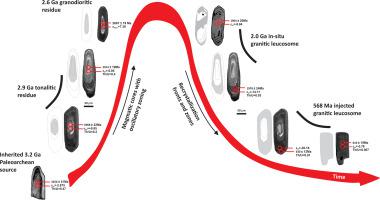当前位置:
X-MOL 学术
›
Gondwana Res.
›
论文详情
Our official English website, www.x-mol.net, welcomes your
feedback! (Note: you will need to create a separate account there.)
Multiple stages of migmatite generation during the Archean to Proterozoic crustal evolution in the Borborema Province, Northeast Brazil
Gondwana Research ( IF 7.2 ) Pub Date : 2021-02-01 , DOI: 10.1016/j.gr.2020.09.005 Alanielson da Câmara Dantas Ferreira , Elton Luiz Dantas , Reinhardt A. Fuck , Ingrid Moerschberger Nedel , Wolf Uwe Reimold
Gondwana Research ( IF 7.2 ) Pub Date : 2021-02-01 , DOI: 10.1016/j.gr.2020.09.005 Alanielson da Câmara Dantas Ferreira , Elton Luiz Dantas , Reinhardt A. Fuck , Ingrid Moerschberger Nedel , Wolf Uwe Reimold

|
Abstract Multiple partial melting events are documented for Archean to Neoproterozoic migmatites in the Campo Grande granitoid terrain of the Borborema Province of NE Brazil. The migmatites bear evidence of a complex history with different melt generations evidenced by 2.9 Ga tonalite, 2.65 Ga granodiorite, 1.95 Ga in-situ granite leucosomes, and c. 570 Ma injected alkali-feldspar granite leucosomes. Pb-Hf-Nd isotopes reveal c. 2.9 Ga juvenile and 3.25 Ga reworked sources for the 2.9 Ga tonalite and 2.65 Ga granodiorite residue. The 1.95 Ga Paleoproterozoic in-situ granite leucosomes show strong negative to weakly positive eHf(t) and eNd(t) values, with TDM(Hf and Nd) model ages between 2.4 and 2.9 Ga. In contrast, the c. 570 Ma Neoproterozoic injected alkali-feldspar granite leucosomes have more negative eHf (t) and eNd(t) values, with younger TDM(Hf and Nd) of 2.1–2.3 Ga. However, all migmatite components show a progressive increase of LILE and HREE elements from 2.9 Ga tonalite to c. 570 Ma alkaline granite phases, which indicates differentiation of continental crust in this region. The partial melting processes could have been the result of magmatic heating and release of H2O-rich fluids due to 1.95 Ga and c. 570 Ma post-collisional magmatism. Thus, Archean tonalitic and granodioritic protoliths went through multiple Proterozoic orthoderived leucosome generations within the continental crust, suggesting that crustal reworking by anatexis was a crucial factor in the complex evolution of this migmatite terrain.
中文翻译:

巴西东北部 Borborema 省太古代至元古代地壳演化过程中混合岩的多个阶段生成
摘要 在巴西东北部 Borborema 省的 Campo Grande 花岗岩中,记录了太古代至新元古代混合岩的多次部分熔融事件。混合岩具有不同熔体世代的复杂历史证据,由 2.9 Ga 闪长岩、2.65 Ga 花岗闪长岩、1.95 Ga 原位花岗岩白质体和 c. 570 Ma 注入碱长石花岗岩白质体。Pb-Hf-Nd 同位素显示 c。2.9 Ga 幼年和 3.25 Ga 重新加工的 2.9 Ga 闪长岩和 2.65 Ga 花岗闪长岩残渣的来源。1.95 Ga 古元古代原位花岗岩白质体显示出强负到弱正 eHf(t) 和 eNd(t) 值,TDM(Hf 和 Nd) 模型年龄在 2.4 和 2.9 Ga 之间。相比之下,c。570 Ma 注入的新元古代碱长石花岗岩白质体具有更多的负 eHf (t) 和 eNd(t) 值,具有 2.1-2.3 Ga 的年轻 TDM(Hf 和 Nd)。然而,所有混合岩成分都显示出 LILE 和 HREE 元素从 2.9 Ga 到 c 的渐进式增加。570 Ma碱性花岗岩相,表明该地区大陆地壳分异。由于 1.95 Ga 和 c,部分熔融过程可能是岩浆加热和富含 H2O 流体释放的结果。570 Ma 碰撞后岩浆作用。因此,太古宙色调岩和花岗闪长岩原岩在大陆地壳内经历了多次元古代正源性白质体世代,这表明地壳再加工是这种混合岩地形复杂演化的关键因素。570 Ma碱性花岗岩相,表明该地区大陆地壳分异。由于 1.95 Ga 和 c,部分熔融过程可能是岩浆加热和富含 H2O 流体释放的结果。570 Ma 碰撞后岩浆作用。因此,太古宙色调岩和花岗闪长岩原岩在大陆地壳内经历了多次元古代正源性白质体世代,这表明地壳再加工是这种混合岩地形复杂演化的关键因素。570 Ma碱性花岗岩相,表明该地区大陆地壳分异。由于 1.95 Ga 和 c,部分熔融过程可能是岩浆加热和富含 H2O 流体释放的结果。570 Ma 碰撞后岩浆作用。因此,太古宙色调岩和花岗闪长岩原岩在大陆地壳内经历了多次元古代正源性白质体世代,这表明地壳再加工是这种混合岩地形复杂演化的关键因素。
更新日期:2021-02-01
中文翻译:

巴西东北部 Borborema 省太古代至元古代地壳演化过程中混合岩的多个阶段生成
摘要 在巴西东北部 Borborema 省的 Campo Grande 花岗岩中,记录了太古代至新元古代混合岩的多次部分熔融事件。混合岩具有不同熔体世代的复杂历史证据,由 2.9 Ga 闪长岩、2.65 Ga 花岗闪长岩、1.95 Ga 原位花岗岩白质体和 c. 570 Ma 注入碱长石花岗岩白质体。Pb-Hf-Nd 同位素显示 c。2.9 Ga 幼年和 3.25 Ga 重新加工的 2.9 Ga 闪长岩和 2.65 Ga 花岗闪长岩残渣的来源。1.95 Ga 古元古代原位花岗岩白质体显示出强负到弱正 eHf(t) 和 eNd(t) 值,TDM(Hf 和 Nd) 模型年龄在 2.4 和 2.9 Ga 之间。相比之下,c。570 Ma 注入的新元古代碱长石花岗岩白质体具有更多的负 eHf (t) 和 eNd(t) 值,具有 2.1-2.3 Ga 的年轻 TDM(Hf 和 Nd)。然而,所有混合岩成分都显示出 LILE 和 HREE 元素从 2.9 Ga 到 c 的渐进式增加。570 Ma碱性花岗岩相,表明该地区大陆地壳分异。由于 1.95 Ga 和 c,部分熔融过程可能是岩浆加热和富含 H2O 流体释放的结果。570 Ma 碰撞后岩浆作用。因此,太古宙色调岩和花岗闪长岩原岩在大陆地壳内经历了多次元古代正源性白质体世代,这表明地壳再加工是这种混合岩地形复杂演化的关键因素。570 Ma碱性花岗岩相,表明该地区大陆地壳分异。由于 1.95 Ga 和 c,部分熔融过程可能是岩浆加热和富含 H2O 流体释放的结果。570 Ma 碰撞后岩浆作用。因此,太古宙色调岩和花岗闪长岩原岩在大陆地壳内经历了多次元古代正源性白质体世代,这表明地壳再加工是这种混合岩地形复杂演化的关键因素。570 Ma碱性花岗岩相,表明该地区大陆地壳分异。由于 1.95 Ga 和 c,部分熔融过程可能是岩浆加热和富含 H2O 流体释放的结果。570 Ma 碰撞后岩浆作用。因此,太古宙色调岩和花岗闪长岩原岩在大陆地壳内经历了多次元古代正源性白质体世代,这表明地壳再加工是这种混合岩地形复杂演化的关键因素。











































 京公网安备 11010802027423号
京公网安备 11010802027423号